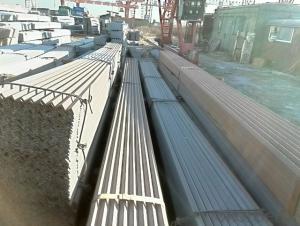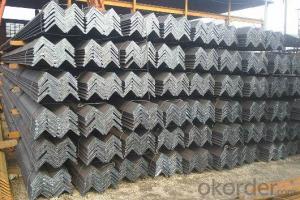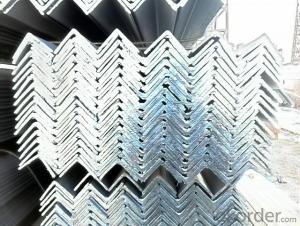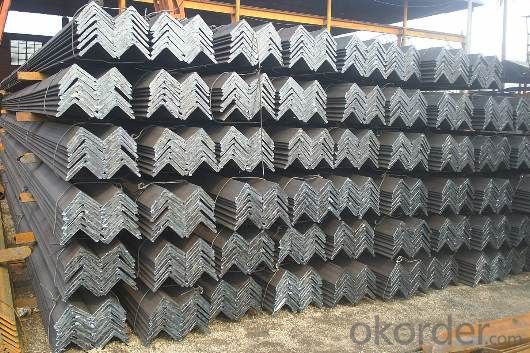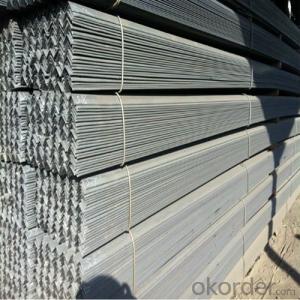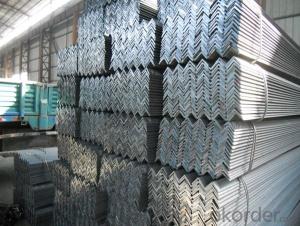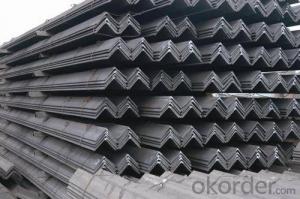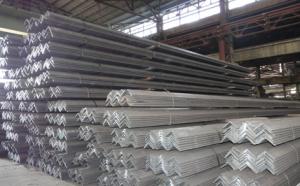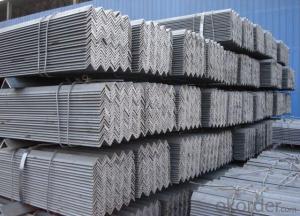Hot Rolled Angle Steel with High Quality
- Loading Port:
- Tianjin
- Payment Terms:
- TT OR LC
- Min Order Qty:
- 25 m.t.
- Supply Capability:
- 20000 m.t./month
OKorder Service Pledge
OKorder Financial Service
You Might Also Like
Product Description:
OKorder is offering high quality Angle Steel at great prices with worldwide shipping. Our supplier is a world-class manufacturer of steel, with our products utilized the world over. OKorder annually supplies products to European, North American and Asian markets. We provide quotations within 24 hours of receiving an inquiry and guarantee competitive prices.
Product Applications:
Angle Steels are ideal for structural applications and are widely used in the construction of buildings and bridges, and the manufacturing, petrochemical, and transportation industries.
Product Advantages:
OKorder's Angle Steels are durable, strong, and resist corrosion.
Main Product Features:
· Premium quality
· Prompt delivery & seaworthy packing (30 days after receiving deposit)
· Corrosion resistance
· Can be recycled and reused
· Mill test certification
· Professional Service
· Competitive pricing
Product Specifications:
Manufacture: Hot rolled
Grade: Q195 – 235
Certificates: ISO, SGS, BV, CIQ
Length: 6m – 12m, as per customer request
Packaging: Export packing, nude packing, bundled
Sizes: 25mm-250mm | ||
a*t | ||
25*2.5-4.0 | 70*6.0-9.0 | 130*9.0-15 |
30*2.5-6.6 | 75*6.0-9.0 | 140*10-14 |
36*3.0-5.0 | 80*5.0-10 | 150*10-20 |
38*2.3-6.0 | 90*7.0-10 | 160*10-16 |
40*3.0-5.0 | 100*6.0-12 | 175*12-15 |
45*4.0-6.0 | 110*8.0-10 | 180*12-18 |
50*4.0-6.0 | 120*6.0-15 | 200*14-25 |
60*4.0-8.0 | 125*8.0-14 | 250*25 |
FAQ:
Q1: Why buy Materials & Equipment from OKorder.com?
A1: All products offered byOKorder.com are carefully selected from China's most reliable manufacturing enterprises. Through its ISO certifications, OKorder.com adheres to the highest standards and a commitment to supply chain safety and customer satisfaction.
Q2: What makes stainless steel stainless?
A2: Stainless steel must contain at least 10.5 % chromium. It is this element that reacts with the oxygen in the air to form a complex chrome-oxide surface layer that is invisible but strong enough to prevent further oxygen from "staining" (rusting) the surface. Higher levels of chromium and the addition of other alloying elements such as nickel and molybdenum enhance this surface layer and improve the corrosion resistance of the stainless material.
Q3: Can stainless steel rust?
A3: Stainless does not "rust" as you think of regular steel rusting with a red oxide on the surface that flakes off. If you see red rust it is probably due to some iron particles that have contaminated the surface of the stainless steel and it is these iron particles that are rusting. Look at the source of the rusting and see if you can remove it from the surface.
Images:
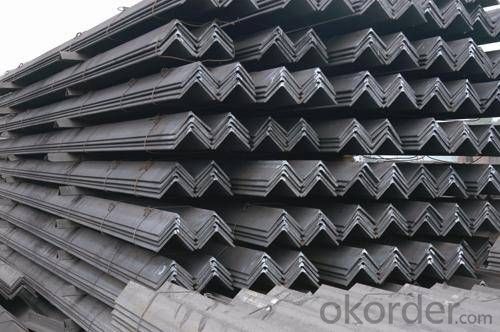
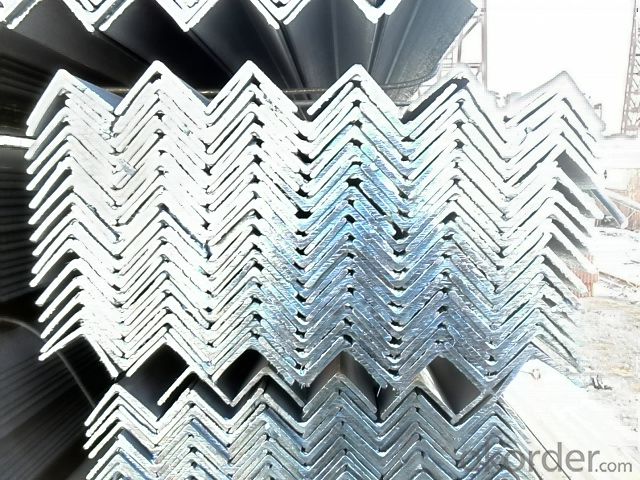

- Q: What are the different types of connections used for steel angles in industrial settings?
- There are various types of connections used for steel angles in industrial settings, including bolted connections, welded connections, and riveted connections. These connections provide structural support and stability to steel angles, ensuring their integrity and strength in industrial applications.
- Q: How do steel angles contribute to the overall durability of a structure?
- Steel angles contribute to the overall durability of a structure by providing structural support and reinforcement. They are commonly used in construction to add strength and stability to various components of a building, such as beams, columns, and frames. The L-shaped design of steel angles allows them to effectively distribute and transfer loads, reducing the risk of deformation, collapse, or failure. Additionally, their high tensile strength and resistance to bending and twisting make them ideal for withstanding heavy loads, seismic forces, and adverse environmental conditions, thus enhancing the durability and longevity of the structure.
- Q: What is the maximum deflection allowed for a steel angle?
- The maximum deflection permitted for a steel angle relies on multiple factors, including the size, shape, and type of steel angle utilized, as well as the specific application and design prerequisites. To ensure structural integrity and safety, the deflection limit is typically determined in accordance with engineering standards and codes. Steel angles are generally engineered to withstand diverse loads and stresses, and their allowable deflection is determined based on these considerations. Engineers calculate the maximum permissible deflection to ensure that the angle can support applied loads securely, without experiencing excessive deformation or failure. To ascertain the maximum deflection allowed for a particular steel angle, one must refer to design standards and specifications provided by professional engineering organizations, such as the American Institute of Steel Construction (AISC), or relevant building codes. These documents outline the maximum permissible deflection limits based on specific parameters of the steel angle, including dimensions, material properties, and intended usage. Consulting the appropriate design standards and codes is crucial to ensuring compliance with safety regulations and guaranteeing the structural integrity of the steel angle in its intended application.
- Q: Can steel angles be used for decorative purposes?
- Yes, steel angles can definitely be used for decorative purposes. Steel angles are versatile and can be shaped and formed into various designs and patterns, making them a popular choice for adding a decorative touch to interior and exterior spaces. They can be used to create decorative accents such as trim, frames, and brackets. Additionally, steel angles can be easily painted or powder-coated in different colors to match any desired aesthetic. The durability and strength of steel angles also ensure that they will withstand the test of time, making them a practical and attractive option for decorative applications.
- Q: Can steel angles be painted or coated after installation?
- After installation, it is possible to paint or coat steel angles for extra protection against corrosion and improved aesthetic appeal. Before painting or coating, it is crucial to cleanse and prepare the surface by eliminating any dirt, rust, or contaminants. This can be achieved by employing methods such as sandblasting, wire brushing, or utilizing chemical cleaners. Once the surface is clean and dry, a suitable primer can be administered to enhance adhesion and prevent corrosion. Following the drying of the primer, a final layer of paint or coating can be applied via a brush, roller, or spray. It is vital to select a paint or coating that is explicitly formulated for steel and provides the desired level of protection and durability.
- Q: Can steel angles be used for HVAC ductwork support?
- Certainly, HVAC ductwork support can indeed be achieved through the utilization of steel angles. In construction endeavors, steel angles are frequently employed due to their commendable resilience and robustness. They offer superb reinforcement for an array of purposes, encompassing HVAC ductwork systems. It is effortless to fashion and deploy steel angles, thereby establishing a steadfast structure for the ductwork, guaranteeing stability and optimal operation of the system. Furthermore, steel angles possess the capacity to endure the weight and force applied by the ductwork while exhibiting resistance against corrosion. Consequently, they prove to be an apt preference for prolonged utilization.
- Q: What are steel angles?
- Steel angles are a type of steel structural shape that is commonly used in construction and engineering projects. They are L-shaped beams with two legs of equal or unequal length, forming a 90-degree angle. Steel angles are typically made from hot-rolled steel and can be found in various sizes and thicknesses. These angles are versatile and have a wide range of applications. They are commonly used as framing elements in buildings and bridges, providing support and stability. Steel angles can also be used as reinforcement in concrete structures or as brackets and supports for various equipment and machinery. One of the key advantages of steel angles is their strength and durability. They are designed to withstand heavy loads and provide structural integrity. Additionally, steel angles are resistant to corrosion, making them suitable for outdoor applications and environments with high moisture or chemical exposure. Steel angles are available in different grades, with each grade having specific mechanical properties and characteristics. This allows engineers and designers to choose the appropriate angle based on the requirements of the project. In conclusion, steel angles are essential components in construction and engineering. They provide strength, stability, and versatility in various applications. Whether it is for structural support or reinforcement, steel angles play a crucial role in ensuring the integrity and safety of a wide range of structures.
- Q: Do steel angles come with any warranties?
- Yes, steel angles typically come with warranties provided by the manufacturer or supplier. These warranties may vary in terms of duration and coverage, so it is important to check the specific warranty details offered by the supplier before making a purchase.
- Q: Can steel angles be used for window frames?
- Yes, steel angles can be used for window frames. Steel angles are commonly used in construction due to their strength and durability. They provide excellent structural support and can withstand heavy loads, making them suitable for window frames. Additionally, steel angles can be easily fabricated and customized to fit specific window sizes and shapes. They also offer resistance to corrosion, ensuring longevity and minimal maintenance requirements. Therefore, steel angles are a popular choice for window frames in various applications, including commercial buildings, residential homes, and industrial facilities.
- Q: How do steel angles perform in saltwater environments?
- Due to their excellent corrosion resistance, steel angles exhibit strong performance in saltwater environments. Their resistance to corrosion caused by saltwater exposure is enhanced by the inclusion of alloying elements like chromium and nickel in their composition. These alloying elements generate a protective oxide layer on the steel's surface, preventing direct contact between the steel and the corrosive saltwater. Moreover, steel angles can be further safeguarded through coatings or galvanization, which provide an additional barrier against saltwater corrosion. In conclusion, steel angles are a dependable and long-lasting choice for applications in saltwater environments, as they are capable of enduring harsh conditions and maintaining their structural integrity over time.
Send your message to us
Hot Rolled Angle Steel with High Quality
- Loading Port:
- Tianjin
- Payment Terms:
- TT OR LC
- Min Order Qty:
- 25 m.t.
- Supply Capability:
- 20000 m.t./month
OKorder Service Pledge
OKorder Financial Service
Similar products
Hot products
Hot Searches
Related keywords
